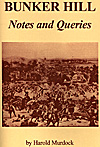 Published by Wee Bee Publishing, 1995.
Published by Wee Bee Publishing, 1995.
softbound, ISBN: 1-888007-07-9
152 pages, plus maps, illustrations, appendices.
This reprint of a 1927 work--and it is one of those "photocopy" reprints--is standard reading for any new seasonal park rangers doing interpretive presentations at the National Park. Inside, Murdock questions many of myths that sprouted from the Battle of Bunker Hill and offers his own analysis of the battle.
He breaks the book up into two main parts: the British attack and the American defense.
British Attack
In the former, he tallies up British forces, outlines the units involved, and investigates the various options of the British council of war. That the British were ready for a stand-up fight is not disputed, but the opinions of various officers on how to beat the rebels entrenched on the Charlestown heights comes to light under Murdock's relentless examination. The description of the attack itself uses a considerable number of excerpts from letters, lists, and other original sources to define the advance and battle--not to mention comment on the tactics employed by the British officers that day.
- For the third time Howe seems to have shifted his plans when he began his concentration against the redoubt and breastwork. Perhaps it was in connection with this maneuver that another misfortune occurred to try his soul. It was whispered on high authority that his orders were so badly conceived or so clumsily executed as to create a confusion in which certain British units suffered losses by the fire of their comrades.
Footnote: Charles Stuart, in his memorandum, cited in previous notes, had this to say: "the line marched from an [exterior?] point without the disposition being alter'd caused the Corps naturally to crowd upon one another and made a confusion in which we suffer'd as much from our own fire as the enemy's." (page 26-27)
American Defense
This section starts with an examination of source material--all too scarce as Murdock sees it, and made even worse by 1818 post-war recollections that were extremely re-interpretive. He then goes through the American forces that were there, or ought to have been there, as there were some discrepancies, and the entrenching efforts of the defenders.
- Probably to Knowlton belongs the credit for the construction of the rail fence, although it is also probably that he was assisted by a "party of Hampshire" and by certain other adventurous souls who were inspired by their example. The seizure and defense of this line made possible the Battle of Bunker Hill and probably prevented an almost bloodless victory for Howe. Vital as this position was to the American cause, we have almost nothing from high sources describing its defense. (page 66)
Through the British attack and the subsequent sorting out of casualties, Murdock continues to pound away at original source material and fit all the sources opinions together. In the end, Bunker Hill Notes & Queries provides a concise examination of a much embellished battle.
Of note, the book contains chapters which add to the main narratives with interesting anecdotes and analysis: Thacher's Report to the Committee of Safety, the Story of Rev. Martin, the Sensitiveness of Gen. Clinton, and the Myth of the Royal Welch Fusiliers.
Succinct
If this book is good enough for the park rangers, it's a good enough starting point, and succintly retells the attack and defense. It offers some excellent discussion about numbers and terrain, analyzes the motivations and actions of officers on both sides, and while not a burning page-turner style, ambles along well enough. Since it was written in 1927, newer scholarship has undoubtedly added to the knowledge of the battle, but for an introduction, it is quite sufficient to bring the battle into focus.
For more information, e-mail: cparker868@aol.com
Back to List of Book Reviews: Horse and Musket
Back to Master Book Review List
Back to Master Magazine List
© Copyright 1997 by Coalition Web, Inc.
This article appears in MagWeb (Magazine Web) on the Internet World Wide Web.
Other military history articles and gaming articles are available at http://www.magweb.com